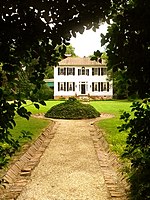American Spinning Company Mill No. 2

The American Spinning Company Mill No. 2 is a historic mill complex at 300 Hammett Street, in a pocket of unincorporated Greenville County, South Carolina surrounded on three sides by the city of Greenville. It is a five-story brick building, to which a number of warehouse buildings and other additions were made. It was built in 1901-02, as part of a major expansion to the American Spinning Company's Mill No. 1, which originally stood just south of Hammett Street. It was built by Oscar Sampson, a Boston textile manufacturer to a design by the industrial design firm Lockwood and Greene, and is one of thirteen early 20th-century mills surviving in the Greenville area. It was listed on the National Register of Historic Places in 2016. Its major tenant now is the Victor Mill Company, a furniture maker.
Excerpt from the Wikipedia article American Spinning Company Mill No. 2 (License: CC BY-SA 3.0, Authors, Images).American Spinning Company Mill No. 2
Hammett Street,
Geographical coordinates (GPS) Address External links Nearby Places Show on map
Geographical coordinates (GPS)
| Latitude | Longitude |
|---|---|
| N 34.873333333333 ° | E -82.412222222222 ° |
Address
American Spinning Company Mill No. 2
Hammett Street 300
29609
South Carolina, United States
Open on Google Maps








